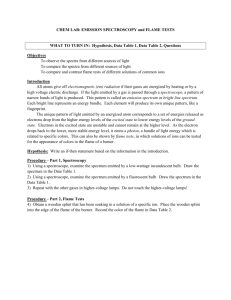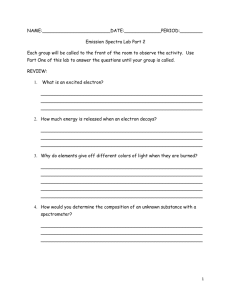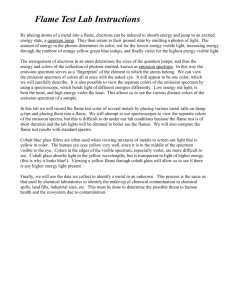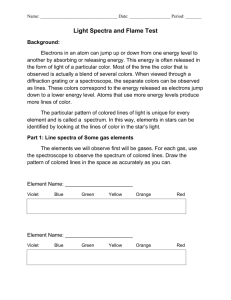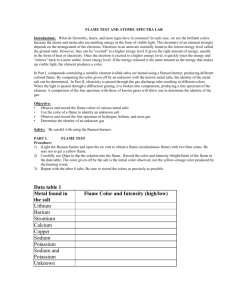Lab Flame Tests
advertisement
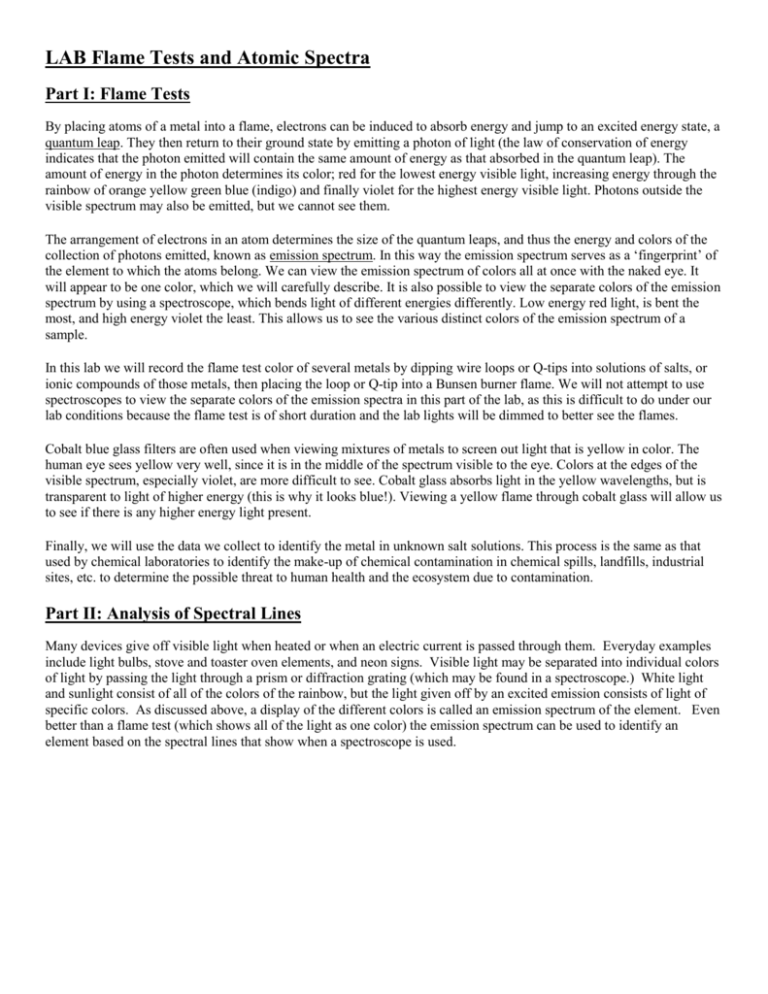
LAB Flame Tests and Atomic Spectra Part I: Flame Tests By placing atoms of a metal into a flame, electrons can be induced to absorb energy and jump to an excited energy state, a quantum leap. They then return to their ground state by emitting a photon of light (the law of conservation of energy indicates that the photon emitted will contain the same amount of energy as that absorbed in the quantum leap). The amount of energy in the photon determines its color; red for the lowest energy visible light, increasing energy through the rainbow of orange yellow green blue (indigo) and finally violet for the highest energy visible light. Photons outside the visible spectrum may also be emitted, but we cannot see them. The arrangement of electrons in an atom determines the size of the quantum leaps, and thus the energy and colors of the collection of photons emitted, known as emission spectrum. In this way the emission spectrum serves as a ‘fingerprint’ of the element to which the atoms belong. We can view the emission spectrum of colors all at once with the naked eye. It will appear to be one color, which we will carefully describe. It is also possible to view the separate colors of the emission spectrum by using a spectroscope, which bends light of different energies differently. Low energy red light, is bent the most, and high energy violet the least. This allows us to see the various distinct colors of the emission spectrum of a sample. In this lab we will record the flame test color of several metals by dipping wire loops or Q-tips into solutions of salts, or ionic compounds of those metals, then placing the loop or Q-tip into a Bunsen burner flame. We will not attempt to use spectroscopes to view the separate colors of the emission spectra in this part of the lab, as this is difficult to do under our lab conditions because the flame test is of short duration and the lab lights will be dimmed to better see the flames. Cobalt blue glass filters are often used when viewing mixtures of metals to screen out light that is yellow in color. The human eye sees yellow very well, since it is in the middle of the spectrum visible to the eye. Colors at the edges of the visible spectrum, especially violet, are more difficult to see. Cobalt glass absorbs light in the yellow wavelengths, but is transparent to light of higher energy (this is why it looks blue!). Viewing a yellow flame through cobalt glass will allow us to see if there is any higher energy light present. Finally, we will use the data we collect to identify the metal in unknown salt solutions. This process is the same as that used by chemical laboratories to identify the make-up of chemical contamination in chemical spills, landfills, industrial sites, etc. to determine the possible threat to human health and the ecosystem due to contamination. Part II: Analysis of Spectral Lines Many devices give off visible light when heated or when an electric current is passed through them. Everyday examples include light bulbs, stove and toaster oven elements, and neon signs. Visible light may be separated into individual colors of light by passing the light through a prism or diffraction grating (which may be found in a spectroscope.) White light and sunlight consist of all of the colors of the rainbow, but the light given off by an excited emission consists of light of specific colors. As discussed above, a display of the different colors is called an emission spectrum of the element. Even better than a flame test (which shows all of the light as one color) the emission spectrum can be used to identify an element based on the spectral lines that show when a spectroscope is used. Procedure Part I (Flame Tests) 1. 2. 3. 4. 5. 6. When the class is ready, go to your assigned “starting point” for the rotation part of this lab. Your station will have a container of a solution of an ionic compound that contains the metal ion marked on the cover of the container. Two stations have containers marked as “unknown”. If you are one of the first to be assigned to a lab station, safely light the Bunsen burner to a low blue flame. The flame will stay on until the class is finished with this part of the lab. At each station, dip the wire loop or Q-tip into the solution, then put the tip into the EDGE of the blue flame near the tip of the inner cone. Record your observation of the color of the flame next to the appropriate metal ion on the data table. You should record specifics of the color, as there will likely be varying shades of red, orange, etc. as you will need good observations in order to be able to identify the unknowns. DO NOT ALLOW THE Q-TIP TO BURN! Place used Q-tip at the back of the station for clean-up at the end. Now get ready to test another ion. When it is time, rotate one station clock-wise. Take care, as the burners at all stations will remain lit. Repeat the process used for the first ion. Test all of the salt solutions and make sure that you record the color of the flame for each metal ion in the Data Table. After testing and recording your results, compare your known data to that of the unknown “mystery” ions. Your job is to identify them through their flame tests. Write the identities in the space on your data table. The two mixtures each have 2 ions in them – see if you can identify them and write them in the space on the data table! Procedure Part II (Spectral Lines) 1. 2. Observe the spectra emitted by different gases in spectral tubes as they are shown by your teacher or as you visit them around the room. Record in your data table the identity of the gas and the color of light as you see it with your “naked” eye. Use a spectroscope to observe the emission (bright-line) spectrum of each gas. In the box below the data table, use colored pencils or crayons to draw the spectrum as you see it for any TWO of the gases in the spectral tubes.
